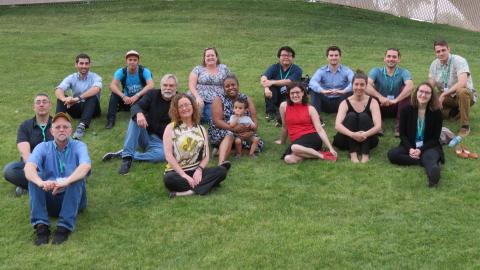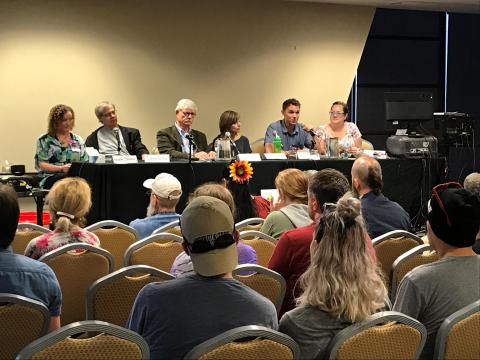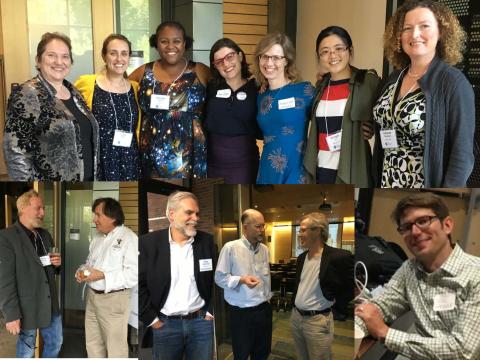In the Ford Environmental Science and Technology Building, the office of Martha Grover is three doors from that of Jennifer Glass. Both are Georgia Tech scientists doing research related to astrobiology – life in the cosmos – but until last year they hardly talked to each other as researchers with common interests. Now, Grover, Glass, and others at Tech are members of a growing community that’s coalescing astrobiology activities across campus.
In the Ford Environmental Science and Technology Building, the office of Martha Grover is three doors from that of Jennifer Glass. Both are Georgia Tech scientists doing research related to astrobiology – life in the cosmos – but until last year they hardly talked to each other as researchers with common interests.
“We are all so busy,” says Grover, a professor in the School of Chemical and Biomolecular Engineering, a scientific collaborator at the NSF/NASA Center for Chemical Evolution (CCE), and a member of the Center for Space Technology and Research (C-STAR).
Now, Grover, Glass, and others at Tech are members of a growing community that’s coalescing astrobiology activities across campus. In a public debut of sorts, six members of Georgia Tech Astrobiology, as the community calls itself, participated in the 2017 Dragon Con, the premier pop-culture convention on science fiction and fantasy. They wowed the audience, not by fiction or fantasy or over-the-top costumes, but by progress in answering fundamental questions – How did life begin? Where else could life exist? – happening right next door from the meeting venue, at Georgia Tech.
The growing visibility of researchers interested in astrobiology is helping Georgia Tech emerge as a powerhouse in the field. At minimum, says Kenneth Knoespel, a historian of science and professor in the Ivan Allen College of Liberal Arts, “it affirms the importance of this community at Georgia Tech and the importance of astrobiology as a new configuration of disciplines that brings together the natural and human sciences.”
TEEMING WITH TALENT
“Georgia Tech is clearly recognized as a hub for astrobiology and maybe the one that’s growing the most quickly,” says Edward Goolish, the deputy director of the NASA Astrobiology Institute (NAI), one of the six elements of the NASA Astrobiology Program. People at Georgia Tech, Goolish adds, “have been generous with their time and have contributed in important ways when NASA has reached out to the science community for input.”
The community includes physicists, chemists, biologists, Earth and planetary scientists, and engineers, as well as historians of science and writers. The scientists are figuring out how life emerged and evolved to the biosphere we know, inventing instruments to detect life outside Earth, and searching for other habitable places in the universe. The science historians and writers are witnessing science in the making and perhaps gathering fodder for the next volume of science fiction.
Broadly defined, astrobiology is the study of life in the cosmos. Its central questions are “What is the origin of life?” and “Does life exist beyond Earth?” Humans have asked these questions since time immemorial. That they are still around attests to the difficulty of discovering and assembling the pieces of a formidable puzzle: the emergence of a biosphere on a planet.
How formidable? According to Eric Smith, a theoretician in the NASA Astrobiology Institute’s team at Georgia Tech (NAI-GT), understanding the nature of the transition from a planet without a biosphere to one with a biosphere should be central to origins-of-life inquiries. However, he says, “a lot of the language to enable that understanding doesn’t exist yet.”
THREE PILLARS
At Georgia Tech, research teams are working across the breadth of questions central to astrobiology. Their activities are exemplified by three specialized research groups: CCE, NAI-GT, and C-STAR.
CCE is building a community in origin-of-life research, said its director, Nicholas V. Hud, at a symposium organized by Georgia Tech Astrobiology last month. In finding answers, CCE takes two approaches, Hud explained. “Bottom up,” it starts with geology and chemistry and understanding the formation of the first polymers of life, which is a major focus of Hud’s. “Top down,” it starts with biology, genetics, and looking back in time at persistent, conserved molecular motifs, as exemplified by the work of Loren Williams on ribosomes.
Like digging a tunnel underground from opposite ends and meeting somewhere in between, the two approaches are converging on the coevolution of the biopolymers of life. Chemistry and biology are telling us the same thing, say Hud and Williams, both professors in the School of Chemistry and Biochemistry (SoCB) and members of the Parker H. Petit Institute for Bioengineering and Bioscience (IBB).
At NAI-GT, “we start at the level of the cell,” says Frank Rosenzweig, the School of Biological Sciences (SoBS) professor who leads the NASA group. “Once you have all this biochemistry wrapped in a cell, what happens then? How do they become associated as multicellular organisms? How do they engage in biochemistries that change the environment? We need to understand the interaction between the evolution of life and the evolution of its abiotic surrounding to have a chance of recognizing life elsewhere.
“Although life on Earth manifests in different forms, all are governed by laws of growth, inheritance, and variability,” says Rosenzweig, also a member of IBB. NAI-GT aims to “illuminate and interpret these laws via laboratory-based evolution experiments with microbial populations.” An example is the exploration of the origin of multicellularity by experimentally evolving yeast, as described in the September symposium by Will Ratcliff, an assistant professor in SoBS.
For C-STAR-affiliated faculty, habitability is one key question. What events and conditions in the abiotic sphere yield environments that support life? The NASA-supported work of Jennifer Glass and Chris Reinhard, in the School of Earth and Atmospheric Sciences (EAS), exemplify the search for answers in this realm.
What signals should we monitor in search of life elsewhere in the universe? What tools do we need to probe for signs of life from the comfort of Earth? What hazards should we prepare for if humans were to go to other worlds?
In EAS, C-STAR members and planetary scientists Carol Paty, Britney Schmidt, and James Wray are co-investigators of NASA-funded projects to answer these questions. So is C-STAR member Paul Steffes, in the School of Electrical and Computer Engineering, as well as C-STAR Director Thomas Orlando and C-STAR member Amanda Stockton, in SoCB.
WHAT’S NEXT
With the talent on campus, Georgia Tech is becoming well known in the field of astrobiology. At the 2017 Astrobiology Scientific Conference, in Mesa, Ariz., last April, the Georgia Tech “posse” numbered about 30 faculty and students. Last summer, attendees of AbGradCon (Astrobiology Graduate Conference) 2017 selected Georgia Tech to host the 2018 event. This popular meeting for students is funded primarily by the NASA Astrobiology Institute.
The astrobiology community at Georgia Tech is “healthy,” Smith says. “The people in strategic positions have good priorities in the sophistication and intellectual integrity they are trying to support.”
The community – now 85 strong and growing – is raring to make its presence felt. It has an ambitious schedule for the 2017-18 school year, spearheaded by the September symposium.
Led by Grover as principal investigator, and with contributions from Glass, Knoespel, Paty, Reinhard, Rosenzweig, Schmidt, Williams, and others – Rebecca Burnett, Ivan Allen College of Liberal Arts; Glenn Lightsey, School of Aerospace Engineering and C-STAR; and Christopher Parsons, CCE – their proposal for seven projects received funding from the Georgia Tech Strategic Plan Advisory Group (SPAG) and the Colleges of Engineering, Liberal Arts, and Sciences.
The projects aim to showcase the quality and variety of astrobiology projects at Tech, highlight the social impact of these projects, and strengthen the sense of community among faculty and students. The goals will be achieved through formal gatherings, educational innovations, and public outreach.
“As I see it, the point of research universities is to tackle the really important, really deep, and really challenging questions – the ones at the edge of, or even beyond, our reach; the ones that present not just the possibility but the likelihood of failure,” said College of Sciences Dean and Sutherland Chair Paul M. Goldbart at the September symposium. “It’s our duty as administrators to do everything we can to support this kind of truly adventurous research.”
What the astrobiology community is doing not only is exciting, Goldbart said. But also, “it could hardly fit better with the dreams of the College of Sciences and of Georgia Tech.”
Georgia Tech Researchers Working Toward the Goals of NASA’s Astrobiology Program
Planetary Science and Technology Through Analog Research (P-STAR)
Jennifer Glass, School of Earth and Atmospheric Sciences
Britney Schmidt, School of Earth and Atmospheric Sciences
Amanda Stockton, School of Chemistry and Biochemistry
Planetary Instrument Concepts for the Advancement of Solar System Observations (PICASSO)
Amanda Stockton
Exobiology: Early Evolution of Life and the Biosphere
Frank Rosenzweig, School of Biological Sciences
Exobiology: Evolution of Advanced Life
William Ratcliff, School of Biological Sciences
Exobiology: Prebiotic Evolution
Loren Williams, School of Chemistry and Biochemistry
Exobiology: Methane and Iron Metabolisms in Ancient Oceans
Jennifer Glass
School of Earth and Atmospheric Sciences Faculty Affiliated with NASA Astrobiology Institute (NAI)
Jennifer Glass, Chris Reinhard, and Yuanzhi Tang, with University of California, Riverside, team
James Wray, with SETI Institute team
NAI Team at Georgia Tech School of Biological Sciences
Kim Chen
Phillip Gerrish
Matt Herron
Teresa Jonsson
Kennda Lynch
Frank Rosenzweig
William Ratcliff
Eric Smith
Pedram Samani
Tim Whelan
NASA Postdoctoral Program Fellows
Bradley Burcar, with Nicholas Hud
Peter Conlin, with William Ratcliff
Moran Frenkel-Pinter, with Loren Williams
Kazumi Ozaki, with Chris Reinhard
Nicholas Speller, with Amanda Stockton
2018 AbGradCon Organizers
Marcus Bray Justin Lawrence
Bradley Burcar Adriana Lozoya
Anthony Burnetti Kennda Lynch
Heather Chilton Santiago Mestre Fos
Chase Chivers Marshall Seaton
Dedra Eichstedt Micah Schaible
Zachary Duca Elizabeth Spiers
Jennifer Farrar Scot Sutton
Nicholas Kovacs Nadia Szeinbaum
George Tan, Conference Chair
Note: This list is not meant to be comprehensive; it represents information that was available as of October 2017.
This list was updated on Nov. 21, 2017, to include all members of the NAI Team at Georgia Tech School of Biological Sciences.
PHOTO CAPTIONS
Georgia Tech at AbSciCon 2017. This photo shows only some of the Georgia Tech researchers who attended. From left: Cesar Menor-Salvan, Nick Hud, Justin Lawrence, Jacob Buffo, Frank Rosenzweig, Amanda Stockton, Britney Schmidt, Kennda Lynch, Gavin Mendez, George Tan, Jennifer Glass, Zachary Duca, Nadia Szeinbaum, Aaron McKee, Chloe Stanton, and Marcus Bray (Courtesy of Jennifer Glass)
Georgia Tech Astrobiology at 2017 Dragon Con. From left: Amanda Stockton, Loren Williams, Kenneth Knoespel, Lisa Yaszek, Chris Reinhard, and Britney Schmidt (Photo by Renay San Miguel)
Organizers and Speakers: “Life in the Cosmos.”
Top, from left: Rebecca Burnett, Carol Paty, Kennda Lynch, Jennifer Glass, Martha Grover, Gongjie Li, and Amanda Stockton
Bottom, from left: Thomas Orlando, Paul Steffes, Frank Rosenzweig, Nicholas Hud, Loren Williams, and William Ratcliff (Photos by Maureen Rouhi)
Additional Images



